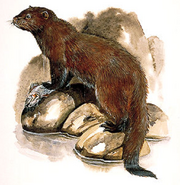| Sea Mink | |
|---|---|
 | |
| Scientific Classification | |
| Kingdom | Animalia |
| Conservation Status | |
 Extinct | |
The Sea Mink (Neovison macrodon) is an extinct species of mink that lived in the eastern coast of North America. It is in the family Mustelidae, the largest family in the order Carnivora. It was most closely related to the American mink (Neovison vison), with continuing debate about whether or not the sea mink should be considered a subspecies of the American mink (making it Neovison vison macrodon) or a species of its own.
Taxonomy and etymology[]
The sea mink was first described as Lutreola macrodon, distinct from the American mink, by Daniel Webster Prentiss, a medical doctor and ornithologist, in 1903 after it became extinct. Prentiss based his description on skull fragments recovered from Native American shell middens in New England. Most sea mink remains, nearly all of them skull fragments, have come from shell middens, but a complete specimen has never been found.
Range[]
The sea mink was a marine mammal that lived around the rocky coasts of New England and the southernmost Maritime Provinces until it was hunted to extinction in the late 19th or early 20th century. Most sea mink remains are unearthed on the coast of Maine. Though it is speculated that they at one point inhabited Connecticut and Rhode Island, they were commonly trapped along the coast of the Bay of Fundy (in the Gulf of Maine), and it is said that they formerly existed on the southwestern coast of Nova Scotia.
Description[]
Since the sea mink has only been described by fragmentary remains, its appearance and behaviors are not well-documented. Its relatives, as well as descriptions by fur traders and Native Americans, give a general idea of this animal's appearance and its ecological roles. Accounts from Native Americans in the New England/Atlantic Canadian regions reported that the sea mink had a fatter body than the American mink. The sea mink produced a distinctive fishy odor, and had fur that was said to be coarser and redder than that of the American mink. It is thought that naturalist Joseph Banks encountered this animal in 1776 in the Strait of Belle Isle, and he described it as being slightly larger than a fox, having long legs, and a tail that was long and tapered towards the end, similar to a greyhound.
Behavior[]
As marine mammal species often play a large part in their ecosystems, it is possible that the sea mink was an important intertidal predator. It may have been similar in diet to the American mink, and may have consumed seabirds, seabird eggs, and hard-bodied marine invertebrates, though in greater proportions. Fur traders reported that sea mink dens had two entrances, and were made in the rocks piled up by the waves. Remains of toad sculpins and ocean pout were the most common around their dens, and garden banded snails were also reported to have been part of their diet. Their seafood-oriented diet may have increased their size.
Exploitation and extinction[]
The sea mink was pursued by fur traders due to its large size; this made it more desirable than other mink species further inland. The unregulated fur trade eventually led to its extinction, which is thought to have occurred between 1860 and 1920.[14][16] The sea mink was seldom sighted after 1860. The last two recorded kills of a sea mink were made in Maine in 1880 near Jonesport, Maine, and Campobello Island, New Brunswick, in 1894,[14] although the 1894 kill is speculated to be of large American minks.[13] Fur traders made traps to catch sea minks and also pursued them with dogs, although they were rarely trapped. If a sea mink escaped into a small hole on the rocky ledges, it was dug out by hunters using shovels and crowbars. If it was out of reach of the hunters, it was shot and then retrieved using an iron rod with a screw on the far end. If it was hiding, it was smoked out and suffocated.[13][15][19] The minks' nocturnal behavior may have been caused from pressure by fur traders who hunted them in daylight.




